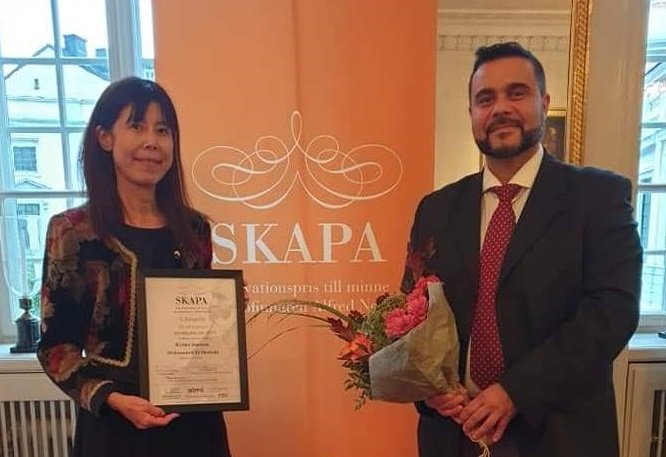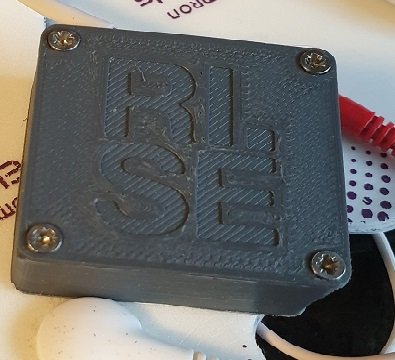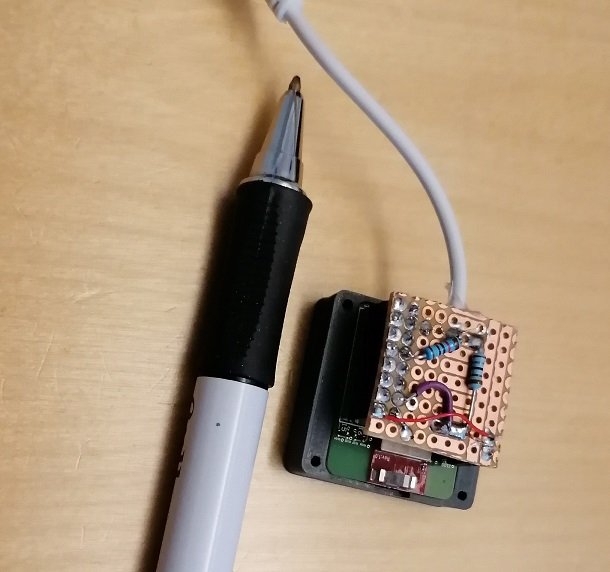WoW Woman in Health Tech I Kyoko Jansson, co-founder of Noui
Kyoko Jansson is the co-founder of Noui, a company developing a real-time bladder scanner “Noui” that uses an electric signal transmission capacitance coupling method to compare the signal strengths and estimate the fluidity of the bladder.
Tell us a bit about your background and your projects so far.
I am an inventor of the wearable real-time bladder scanner "Noui". We developed a unique capacitance coupling method promising safe hygiene for global patients in conditions of incontinence and many other patients with neurological problems.
I have work experience in six countries as a lobbyist, marketing, and business development strategist at multi-national companies such as Ericsson and Volvo. I have an extensive global network through the past external posts of a Chair/Vice-Chair of the American Chamber of Commerce and JMEC, an MBA program, Alumni in Japan. In Sweden, I have co-started the PWG, Professional Women's Group of Gothenburg on the 25th of January 2007 and have been working for digital health and licensing. I have been involved in the HBC (Human Body Communication) working group since 2011 and currently works on the development of "Noui" together with her co-founder and partners.
The company is launching a real-time bladder scanner “Noui” using the electric signal transmission capacitance coupling method to compare the signal strengths and estimate the fluidity of the bladder. It is built on simple electronic construction and tiny size. The electrodes can be integrated into textile computing and printed electronics.
Our mission is to help hospital staff determine the patient’s exact timing for catheterization to minimise fatal cases and infection rates. In electromagnetism, each substance has a specific dielectric constant, and this value is determined by how molecules or fluidity in the substance are responding when an external electric field is formed. When an electric signal is transmitted to an electrode, the received signal voltage that has passed through the bladder will decay according to fluid level. The device measures capacitance by the result of mathematical calculation and unique algorism. You can find out more here.
Our customers are hospitals, incontinence solution providers, elderly care sectors, pharmaceutical companies, and travel agencies. The majority of individuals have certain damage to the nerve pathways and suffer neurological disorders, such as Parkinson's, Diabetes, Stroke, Multiple Sclerosis, Cancer, Trauma, LUTS (lower urinary tract symptoms).
How did you get into this industry? Has it been an easy industry to get into or have you had many challenges?
I had been working on research of the Human Body Communication (WBAN)IEEE802.15.6 a short-range communication technology and reported to the HBC task group on the potential business and development opportunities in the healthcare sectors. In 2011 I was invited to evaluate the capacitance coupling method to determine bladder volume with electronic signal transmission. The methods worked well in the laboratory setting. At that time, I had little knowledge of incontinence. In 2019 I visited a lady at a retirement home in Sweden, I saw another lady asking for assistance with the toilet function. The helpers ignored her as she sat on the absorbent aids. I immediately noticed that in today’s care sector, the work is done extensively with regard to the routine, not with the patient’s safety at the centre. That is why I started developing a bladder scanner and did a deep needs analysis at hospitals, pharmaceutical companies, and retirement homes.
In the Elderly Care Sectors in Europe, each enterprise should bring up an innovative solution together with a better staff behavioural simulation and evidence-based cost-saving scenarios by the Robotics or AI tools. There is another tradition – not to be an early adopter. The reduction of the infection treatment cost of EUR7 billion was not properly addressed. There are ethics and integrity. We would like to focus on respect for each patient, especially elderly women. The care industries are not welcoming to newcomers. However, the medical sectors such as hospitals, clinics, and medical professionals have shown interest and we have moved to further discussions.
How long did it take you to be where you are now? What was the biggest obstacle? What are the challenges of being in the industry you are in?
I have worked for the needs analysis for about a year. The development work took about 1 year. We have now developed the first-generation prototype and produced a number of working prototypes. The prototype works well in the laboratory environment, The challenges are lacking resources financially and physically. We would like to have in-house medical and healthcare professionals continuously observe individual cases and accelerate the development of an MVP faster as possible.
What are your biggest achievements to date?
I was awarded as the most innovative inventor of the year 2020 by the region of Stockholm, the Skapa – a memory of Alfred Nobel and became the regional winner of the prize. When testing the prototypes on the human bodies, we identified some challenges. However, we have successfully removed a large number of external noises.
What are the projects you are currently working on?
We are now working on the second Vinnova (EU funding) project to achieve higher accuracy to estimate the fluidity according to the requirements of the hospitals and the healthcare professionals. In order to integrate into textile computing, we have now the prototype of underwear on super absorbency and quick dry polyester-based scientific fibre.
Is the #WomenInTech movement important to you and if yes, why?
This is yes or no. I had been involved in several women-led organizations, such as FEW Foreign Executive Women, Women in Telecommunication, and International Women's Associations in Tokyo. I gained an experience of empowering women and independence at the FEW and the women-led American Chamber of Commerce Committees in Tokyo where I met amazing talented tech-related women and female scientists, In Tokyo, the concept of #womenintech drew attention in the 90s. I think #woemenintech involves women understanding the technology, its movement, its usage and its contribution and can do performance-enhancing using these technologies. The fast-growing energetic Tokyo culture created such a women-empowered atmosphere. For them, #womenintech is not new, just a different term of the wording. I co-founded PWG, the Professional Women Group of Gothenburg in 2007 in Sweden and tried to promote minded women and girls in STAM to do an invention. Unlike Tokyo, the movement was very slow and I finally saw that the market/industry welcomed #womenintech in Sweden.
What will be the key trends in your industry in the next five years and where do you see them heading?
A Japanese company has now developed a device that could see blood movement and its characteristics. These types of technologies can scan each tissue and organ in the future. There are damages within the nerve pathways, such as brain stem lesions, supranational lesions sacral, pelvic nerve lesions cause incontinence and bladder dysfunction. Scientists may find the mechanism of the brain and develop products to measure the status of each tissue/ muscle movement that may be controlled by neurological signals.
I have been terrified of the advancement of the argumentum and virtual technologies into the rehabilitation and medical industries However, now we could not deny the Metaverse and Cybernetics world would come to live in our daily life. In the very near future, we may not depend on the device but everything such as diagnostics or measurement activities may be done in airspace or near the body.
What is the most important piece of advice you could give to anyone who wants to start a career in this industry?
I would like to advise younger women. Start early. Please consider first why you need to start with your innovation. If you think you can create a solution to a problem, please explore and talk to many people and customers (hospitals, users, and business coaches) where you may end up with your solution in a completely different shaped one and address another pain you have never thought of. Please find the relevant expertise- healthcare and medical expert who devotes time to you.
Who are three inspirational women in your respective industry you admire?
Barbara Manning – Direct Marketing and Market Communication Guru who brought a revolution to the digital marketing world in the ’90s and drastically changed its tradition to the totally foreign and unimaginable tactical marketing techniques and elaborating tools in Japan. She had truly contributed to building the phenomenon called ”Japan as a No 1.” in the 90s.
Anne Bargasse – She is the second foreign woman to establish an enterprise in Japan in the early 90. She is a Canadian and her company was a digital publishing and Internet service provider that astonished the entire business scene in Japan. – It was early 1990.
Philippa Langley – She is a play writer and has started the project ”Looking for Richard” in 2004/05. After knocking on the doors to the contributors who had thought she was crazy and ridiculous and finally she raised money. In August 2011, the archaeological team exhumed skeletal remains and with the latest genome science determined to the last Plantagenet King. She is an amazing enthusiast and she is now a lead to solve the most famous murder mystery.
Find out more about Noui on their website.
Connect with Kyoko on LinkedIn.
This interview was conducted by Marija Butkovic, Digital Marketing and PR strategist, founder, and CEO of Women of Wearables. She regularly writes and speaks on topics of wearable tech, fashion tech, IoT, entrepreneurship, and diversity. Follow Marija on Twitter @MarijaButkovic and read her stories for Forbes here.





